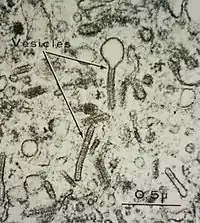Birbeck granules
Birbeck granules, also known as Birbeck bodies, are rod shaped[1] or "tennis-racket" cytoplasmic organelles with a central linear density and a striated appearance. First described in 1961 (where they were simply termed "characteristic granules"),[2] they are solely found in Langerhans cells.[1] Although part of normal Langerhans cell histology, they also provide a mechanism to differentiate Langerhans cell histiocytoses (which are a group of rare conditions collectively known as histiocytoses) from proliferative disorders caused by other cell lines.

Function
The function of Birbeck granules is debated, but one theory is that they migrate to the periphery of the Langerhans cells and release their contents into the extracellular matrix. Another theory is that the Birbeck granule functions in receptor-mediated endocytosis, similar to clathrin-coated pits.
History
Birbeck granules were discovered by Michael Stanley Clive Birbeck (1925–2005), a British scientist and electron microscopist who worked at the Chester Beatty Cancer Research Institute or Institute of Cancer Research, London from 1950 until 1981.[4]
References
| Wikimedia Commons has media related to Birbeck granules. |
- Mc Dermott R, Ziylan U, Spehner D, et al. (January 2002). "Birbeck granules are subdomains of the endosomal recycling compartment in human epidermal Langerhans cells, which form where langerin accumulates". Mol. Biol. Cell. 13 (1): 317–35. doi:10.1091/mbc.01-06-0300. PMC 65091. PMID 11809842.
- Birbeck MS, Breathnach AS, Everall JD (July 1961). "An electron microscope study of basal melanocytes and high-level clear cells (Langerhans cells) in vitiligo". Journal of Investigative Dermatology. 37 (1): 51–64. doi:10.1038/jid.1961.80.
- Kissenpfennig A, Aït-Yahia S, Clair-Moninot V, et al. (January 2005). "Disruption of the langerin/CD207 gene abolishes Birbeck granules without a marked loss of Langerhans cell function". Mol. Cell. Biol. 25 (1): 88–99. doi:10.1128/MCB.25.1.88-99.2005. PMC 538791. PMID 15601833.
- Birbeck's granules at Who Named It?